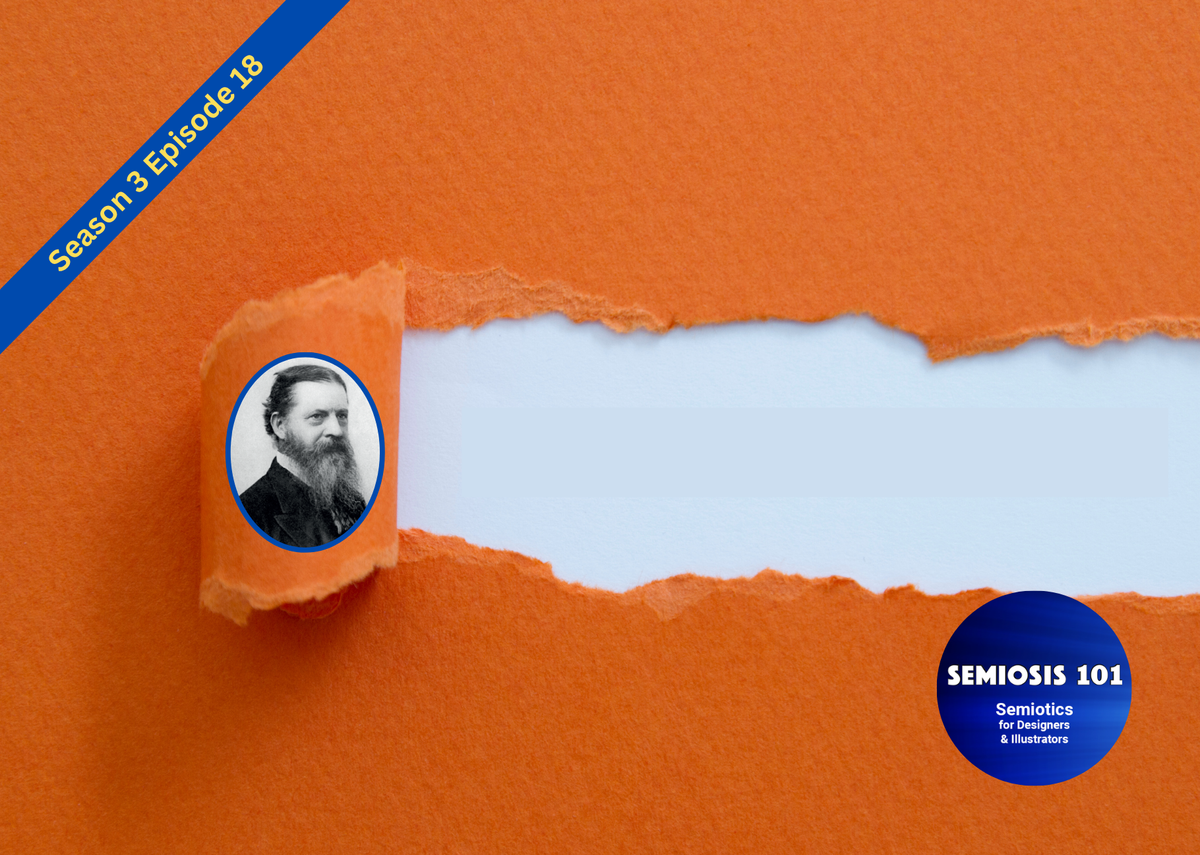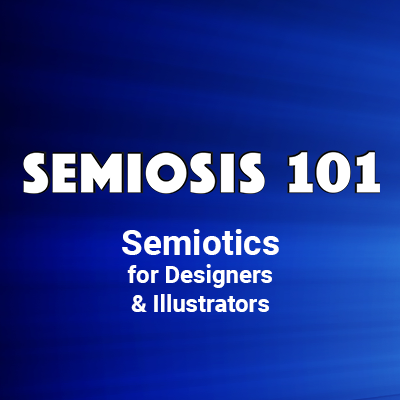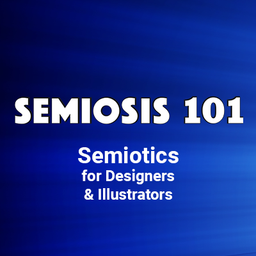Free Semiosis 101 Transcript 3.18:

THE HOW TO OF HOW TOS: Semiotic Sign-action-in-action
Hello readers.
In this free transcript for the REDUX episode published on Semiosis 101 on Weds 14th September 2024, I will illustrate what we have learnt in this season, using an example of illustration.
Watch the free episode on YouTube for the full impact…
…and here is the episode’s transcript.
How is Semiosis used in existing creative work?
This season we have focused specifically on how to encode semiotic signs. To do this, I have explained more of Peirce’s obtuse terms into designer-centric examples. Now as season three begins to wrap this theme up, in this episode and the next, we will look at two design and illustration examples of applied Semiosis at work.
Let us jump straight in…
Okay.
What is the illustration project example then?
That will be a set of picture book illustrations I created as a private commission for a surprise 21st birthday present for my niece Sarah. Featuring her alter ego Princess Sazzles. The Freshfield Tiger narrative is an in-joke between us, based on a forest walk we had when she was five.
I will now use the Princess Sazzles to demonstrate how and where I encoded Semiosis, with the caveat I have already previously stated, that learning semiotics is not a How TO guide book. The illustrations are a visual flow to get its target audience (the reader) to keep turning the pages, to reach the end of a book. This episode’s focus is instead a HOW TO… how to through example. That means learning by example, rather than a specific step-by-step linear guide.
OKAY? You get the difference?
Good.
If not spend time watching the omnibus episodes to catch up on the cognitive differences in the approaches. Right here is how I am going to present this HOW TO… how to episode, I will start on the macro level meaning-bearing, in a state that Peirce calls Thirdness. Then using both visual examples I dig deeper through his state of Secondness, to the micro level of meaning-bearing in a state of Firstness.
Is this already sounding too woo-woo?
Okay, let us begin with what we see and worry about Peirce’s perception states later. I can talk with authority on how the illustrations drip with semiotic signs.
In the Princess Sazzles set of illustrations we see picture book pages. In their specific ways, within the visuals you see, [they are] meaning-bearing… to tell an actual story. For the primary target audience (my niece), the range of visual communication outcomes were intended to lead them to one of two intended outcomes:
• for my niece, Sarah, to reach the end of her 21st birthday present to the last page
• to get the joke.
You viewers are not the primary audience.
In the case of the Princess Sazzles illustrations, I chose a visual language of established fairy tale visual tropes, to first establish the Sazzles character and the adventure. Later in the actual book’s narrative these tropes are subverted in a Tex Avery manner, which breaks the “4th wall” of narrative storytelling. For my niece Sarah to get the joke!
On a semiotic level this is subtle, and neither linear nor denotational. The depth of encoded meaning-bearing is released dependent on the different target audiences’ perceptions …and lived experiences. The more each audience member interprets, the richer the meaning they understand.
The same visual outputs can be interpreted on three different levels. In episodes 3.1-3.4 (omnibus 3.1) I put Peirce’s theory of the effects of interpreting into designer-centric contexts. To quickly summarise this into a pragmatic semiotic context, the effects on how people will interpret begin at an immediate effect level, then may continue to a dynamic effect, and hopefully end at a final effect.
If you see princess. Great.
You are at an immediate effect level of interpreting.
From an immediate level (micro), from the basic visual facts are gathered by the intended audience…
Visually… Young girl, crown, walking, castle, forest path, etc.
=
immediate interpretation… Princess on an adventure.
Great.
Job’s a goodun.’
Meaning gained.
Yes?
We know there is more. If you realise the images have more meaning than that, well…
Moving beyond the immediate interpretations of princess, the works have more meaning to visually communicate. We can frivolously call this the So What? stage. Or the dynamic effect as Peirce names it, when what is seen proposes more than simply denotating “princess.” Why THAT princess, visualised in THAT way? Why is the princess in pink with a crown that moves into different positions, etc. etc. These examples of meaning-bearing are not accidental …but ENCODED into the visuals. They are PERFORMATIVE and not just DECORATIVE.
Moving from a dynamic effect to a final effect of interpreted meaning. At this level book readers will understand the visuals semiotically represent, and therefore facilitate the audience to the full meaning of what they see. So let us flip straight to the final interpretive effect the examples want to lead their respective target audiences to.
The narrative flow resulting in a narrative breakdown at the end of the book, is visually crafted by the visualisation of the character. Would you believe me if I told you that…
Crown = Emotional State
Well that is the meaning-bearing propositions that are in plain sight. If the audience wishes to unlock richer meaning beyond the obvious. In each depiction of the crown throughout the book, the long points of the crown are prehensile. They react to the narrative action points that the character encounters. From page spread to page spread the crown’s points add extra information.
Princess Sazzles’ emotions begin with confidence, through determination, worry, accusations, demands, and finally anger when the joke is revealed. On first sight, none of that detail would ever be possibly known by the audience. Only those audience members with the perception to unlock deeper meaning would. These levels of encoded deeper meaning lie dormant until interpreted. Hence Peirce’s state of Secondness needs the state of Firstness, to semiotically bait the triggering of perception. To propose further interpretations and richer meanings.
From an illustrator’s or designer’s point of view, this is the state that the semiotic sign-action (Semiosis) facilitates. For the audience to make the perceptual jump from “that resembles X” to “that proposes Z.” Secondness is just how Peirce defines that point when perception moves from, “Oh it is just THAT” to “OH! That is about THIS.”
So, let us now parse the Princess Sazzles illustrations to reveal the application of semiotic sign-action, AND where secondary and tertiary audiences can still benefit along the way.
The Princess’ crown is just pencil strokes. Iconically, the yellow line is too weak to semiotically facilitate an audience member to interpret “Princess Sazzles is worried!” But as an Iconic quality carefully, composed with other Iconic qualities, the shapes can be composited and crafted to form a crown. These Iconic elements at this Firstness perception point have been perceived (interpreted) as existent things known to the audience.
They have moved to an Indexical representation level, and perception to a level of Secondness. Now a crown can propose a deeper meaning within the visual communication, that is encoded in plain sight. Let us quickly summarise this into a quick takeaway.
It is fine if some of the audience never realises any of these points. The imagery are still meaning-bearing. They are visually communicating something to someone about Princess Sazzles. The visuals can still convey “crown” has a relationship to princesses. Everyone is still happy. Semiosis has got the audience that far. The audience’s perception just has not been triggered to interpret more.
Yet.
What is crucial to understand now, as this 10-minute episode draws to a close, is that the semiotic HOW TO of how to semiotically encode meaning, is prevalent on one thing from the creative. Whether a designer or illustrator, this one thing is that everything we design or illustrate will always be meaning-bearing. Come back next episode where you can see you have been DOING semiotics ALL the time!
If you want to get a deeper semiotic analysis on how Semiosis works in Princess Sazzles example, then become a Semiosis 101 Producer on Patreon. As part of the great Patreon-only extra content, I have posted longer videos where I go into greater depth. Check them out. This link is in the description below.
See you all again next week for more Semiosis 101 to help illustrators and designers to enhance your visual communication skills.
Semiosis 101 Semiotic Design Resources is a reader-supported publication. To receive exclusive posts and support my work, consider becoming a free or paid subscriber. Paid subscribers get name checked on all future Semiosis 101 YouTube episodes.
===Semiosis 101 Patreon Producer==============
Become a Semiosis 101 Patreon Producer and get a named producer credit on future video episodes, plus watch all new episodes months ahead of YouTube.
===Semiosis 101 Patreon Exclusives==============
Watch longer Patreon-exclusive Semiosis 101 episodes on applying Semiosis into design and illustration…
PATEXC001 How does semiotics work in illustration?





